This week, we look into new ways of putting a tiger in your tank! We find out how pond life could help make eco-friendly biodiesel and how new types of batteries can power electric cars for further than ever before without running out of juice. Plus, how Margaret Thatcher's face can tell us how monkeys recognize each other, what sharks have in common with serial killers and why dolphins are a bit like jet fighters. And in Kitchen Science, we see how batteries work in Arctic conditions.
In this episode

Margaret Thatcher and the Evolution of Face Recognition
Research from Emory University this week shows that we, and our ancestors, have been recognising faces in much the same way for 30 million years or more.
 By watching how Rhesus Macaques respond to a well known optical illusion called the Thatcher effect, professor Robert Hampton and colleagues were able to determine that these monkeys, like us, recognise faces not because we compare them, mentally, to a particular idealised image of a face, but because of the relationship between the different features.
By watching how Rhesus Macaques respond to a well known optical illusion called the Thatcher effect, professor Robert Hampton and colleagues were able to determine that these monkeys, like us, recognise faces not because we compare them, mentally, to a particular idealised image of a face, but because of the relationship between the different features.
The Thatcher effect is an optical illusion that many of you will have seen before - it's created by taking a picture of a face, cutting out the eyes and mouth, then turning them upside down. When you see this image completely upside down (so the eyes and mouth are actually the right way up, but the whole head is rotated), it's hard to see anything wrong with it. It's only when the head is the right way up (meaning the eyes and lips are upside down) that it looks grotesque, and clearly not right.
It's thought that this effect works in humans because we perceive faces as a configuration, rather than an image - this makes us more sensitive to differences in configuration, and makes us more able to recognise individuals.
If monkeys see faces in the same way, then the Thatcher effect should work on them as well.
To test this, the researchers showed some Rhesus macaques some pictures of other Rhesus monkeys' faces, some normal, some upside down and some Thatcherised, and monitored how much attention they paid to each set of images. Once the monkeys had habituated to the photos, they showed no more interest in upside down Thatcherised images than they did normal faces. But when the Thatcherised images were shown the right way up, they paid significantly more attention to them.
This suggests that the monkeys detect faces in the same way as us, as a configuration, and so that this may have evolved at least 30 million years ago, in our common ancestor with the macaques.
Previous studies have shown Thatcherised images to have no effect on pigeons or baboons, which may seem to contradict these results. However, in the baboon study, published in the American Journal of Primatology in 2008, the animals were extensively trained with a small set of images, and so may not indicate the same spontaneous effect as seen in humans.
"This direct evidence of configural face perception in monkeys, collected under testing conditions that closely parallel those used with humans, indicates that perceptual mechanisms for individual recognition have been conserved through primate cognitive evolution," said Professor Hampton.
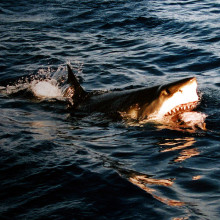
Serial killer sharks
Scientists have shed light on how those iconic ocean predators, great white sharks, go about catching their prey. It turns out they have something in common with human serial killers.
 Great white sharks lurk in spots that don't just guarantee them the best chance of encountering seals but they try and minimise the chances that seals will spot them before they launch an attack. They also take into account where other sharks are.
Great white sharks lurk in spots that don't just guarantee them the best chance of encountering seals but they try and minimise the chances that seals will spot them before they launch an attack. They also take into account where other sharks are.
The shark research team, lead by PhD student Neil Hammerschlag from the University of Miami in the US, took advantage of the way great white sharks in False Bay in South Africa attack their favourite food, cape seals. They target young solitary seals at the sea surface when light levels are low. They lurk at the sea floor, stalking the seals before ambushing them in a sudden vertical rush that propels both shark and seal out of the water. This strategy gives the sharks the best chance sneaking up on the seals and delivering a single fatal bite.
The researchers recorded 340 shark attacks which can be seen from quite a distance across the water and pinpointed the location using GPS units.
To analyse the data the researchers teamed up with Kim Rossmo, a criminal justice expert, who developed computer software to study the geographic patterns of human crimes including terrorist attacks and serial killers - a process called geographic profiling. By looking at where serial crimes take place, the software narrows down an "anchor point" for the criminal, usually their home or place of work. So Hammerschlag and the shark team plugged their hunting data into the same software.
The sharks attacked in non-random patterns and, like human criminals, had their own anchor points. The larger sharks tended to hang out in areas about 100 metres from areas where seals congregate, a vantage point that meant they didn't scare the sea colony, but from where they could easily pick off any seals that stray from the main group.
Smaller, younger sharks hunted over a wider area and were less successful in killing seals than larger sharks. This suggests that as they get older, sharks gain experience and learn to refine their search patterns, concentrating on areas where they are most successful. And it could be that the larger sharks aggressively keep out smaller sharks from the best hunting spots.
Unveiling some of the mystery behind these incredible predators is not only providing fascinating insights into how they successfully catch prey, but perhaps it will also help us understand more about areas where people would do best to avoid, in case they are mistaken for a seal, hanging around on the sea surface.

09:34 - In-Flight Mind Reading
In-Flight Mind Reading
In a first study of its kind, researchers have recorded what's going on in a pigeon's brain during flight...
Writing in the journal Current Biology, researchers at the University of Zurich wanted to know if familiar landmarks could be associated with changes in brain activity.
The exact methods that homing pigeons use to find their way home are still unclear, though there is some evidence that they rely on their sense of smell, the position of the Sun, the Earth's magnetic field and familiar landmarks. This versatility makes them very difficult to study, because even if you're tracking their flight with GPS, it's hard to say what method they rely on at any particular part of the journey.
By fitting pigeons with a very small electroencephalogram, or EEG, which records electrical activity in the brain, and then combining this data with GPS data for flight paths, the researchers we're able to map brain activity onto geographical areas of interest. The pigeons were monitored as they flew from a release sight back to their loft.
They found 2 distinct levels of brain activity - a middle frequency response, which happened when the pigeons paid visual attention to something; and high-frequency activity which seemed to correspond to familiar objects or when additional cognitive processing is going on.
These results means that we can use the record of brain activity to identify areas of importance for pigeon navigation, that we never could have determined from GPS data alone. This gives us real insight into how birds navigate in the real world.
Interestingly, there were a few bits of the journey with unexplained brain activity - places so close to the loft that they weren't needed for navigation. The researchers called this a 'riddle' and one they only solved when they went to visit theses sights - one was a farm and the other a barn. Both contained colonies of feral pigeons, which clearly caught the study pigeons' attention!
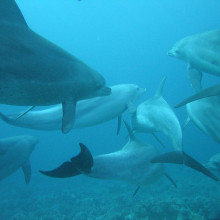
Flying dolphins
Scientists have uncovered the secret behind some dolphin's amazing aquatic acrobatics: they have flippers that work in the same way as delta wing, those characteristic triangular-shaped wings on fighter jet planes, or that feat of 20th century engineering, Concord. So, dolphins can literally fly through the water.
 The research team, led by Laurens Howle and Paul Weber from Duke University, took flippers from 7 species of dead dolphins and whales, either from museum specimens or animals that were stranded on beaches. They produced detailed 3D pictures of the flippers by putting them into a computer tomography, or CT, scanner. Based on these scans, the team then made accurate models of the flippers and then placed them in a flow tunnel with water rushing through it.
The research team, led by Laurens Howle and Paul Weber from Duke University, took flippers from 7 species of dead dolphins and whales, either from museum specimens or animals that were stranded on beaches. They produced detailed 3D pictures of the flippers by putting them into a computer tomography, or CT, scanner. Based on these scans, the team then made accurate models of the flippers and then placed them in a flow tunnel with water rushing through it.
By mounting the model flippers on a set of special weighing scales the team measured two forces, the lift and drag, generated by each flipper at different angles of attack. The key to how wings and flippers work is their tear-shaped cross section. As air - or water - flows over the wing, it has further to travel over the top than across the bottom of the wing, so it speeds up and that results in a lift, pushing the wing upwards. To be stable in the water, the flipper needs to generate enough lift to overcome the drag caused by friction with water, which tries to force the fin backwards.
The different shaped flippers from different performed differently with some species doing better than others. The familiar bottle nosed dolphins generated greatest amount of lift, while the least efficient fins belonged to the harbour porpoise and Atlantic white-sided dolphin.
Some of the dolphins have flippers that act in a similar way to the triangular swept-back wings of fighter jets. They create additional lift with a "leading edge vortex", a swirl of air currents over the front edge of the wing.
This all goes to help explain how some dolphins can swim incredibly quickly, up to 20 miles an hour. These are speeds that until now were thought theoretically impossible because water creates too much friction and drag for these marine mammals to keep swimming against. Now we have a better idea how they do it.

27:15 - Racing Green - Electric and Hybrid Supercars
Racing Green - Electric and Hybrid Supercars
with Dr. Greg Offer & Aaron Kankiwala, Imperial Racing Green
Helen - Electric and hybrid cars do have a bit of an image problem. Many people think they're a bit slow, a bit goody, goody, perhaps a bit worthy, but this week, Meera Senthilingam visited Imperial College London to find out how electric and hybrid cars could soon rival modern petrol hungry muscle cars.
 Meera - This week, I've come to Imperial College London to meet the scientists and engineers of Imperial Racing Green. A project that designs electric and fuel cell hybrid cars for the race track. And with me is Dr. Greg Offer, the Academic Project Manager. Now Greg, firstly, what are electric and hybrid vehicles? How do they work?
Meera - This week, I've come to Imperial College London to meet the scientists and engineers of Imperial Racing Green. A project that designs electric and fuel cell hybrid cars for the race track. And with me is Dr. Greg Offer, the Academic Project Manager. Now Greg, firstly, what are electric and hybrid vehicles? How do they work?
Greg - An electric car is powered by batteries. The batteries need to be charged by electricity which you take from the grids. Every building in this country has a power socket and you can charge the batteries from the power socket. The batteries then power an electric motor which drives the wheels. The main problem with this is actually the amount of power you can get from the socket. Most domestic circuits are limited to 13 amps. So, it will take you quite a few hours to charge your battery.
Meera - And how about the hybrid car?
Greg - There are two types of hybrids. The first is what I would call a first generation hybrid which is like a Toyota Prius. That's an internal combustion engine powered vehicle which has an electric motor and a small battery pack to assist the combustion engine. Second generation hybrids are the more interesting. This is an electric vehicle which is a battery powering, electric motor powering the wheels. And it then has an internal combustion engine, arranged extender to assist the electric vehicle when it's needed. But you can still run it as an electric vehicle.
Meera - Now why would an electric vehicle need assisting?
Greg - The main Achilles' heel of electric vehicles nowadays is the batteries and to deliver the range that consumers are used to, you have to have a lot of batteries which means expensive weight and size. So, in order to overcome some of those problems, we used a range extender.
Meera - Now, what are the advantages then of these hybrid and electric vehicles over an internal combustion engine vehicle?
 Greg - Okay. The principal advantage of the battery electric vehicle is the efficiency. Even now, with the way that we currently generate our electricity in this country which is predominantly through coal and gas burning off, the electric vehicle is still going to produce roughly 50% less CO2 emissions per mile.
Greg - Okay. The principal advantage of the battery electric vehicle is the efficiency. Even now, with the way that we currently generate our electricity in this country which is predominantly through coal and gas burning off, the electric vehicle is still going to produce roughly 50% less CO2 emissions per mile.
Meera - Are there any advantages of the actual performance of the vehicles?
Greg - Yes. Electric vehicles will perform better in terms of acceleration. The electric motor is much more efficient at low revs. In fact, you get all of your power from standing which enables you to accelerate from the line much quicker and combustion engines are remarkably inefficient and don't give you much power when you're accelerating. There's also some other advantages in terms of air quality. Combustion engines produce other emissions in addition to CO2 such as nitrous and sulfurous oxides and those are currently governed by some quite strict regulations which we're getting stricter and stricter. Electric vehicles don't produce any harmful emissions from the vehicle.
Meera - What do you think then the future of these types of vehicles are? Are we likely to see electric vehicles being used by everyone soon?
Greg - Pretty much, every new car on the road within 10 years, I predict will be electric in some form or another. And by 2030, they'll all be plugged in hybrids. And then once we get to 2030, we've probably met our emissions reduction targets. We need to reduce CO2 emissions by about 50% by 2030. We can do that with plug in hybrids. The question is now, it's about scaling up. It's about mass production and actually requires a lot of people. So, training engineers is crucial and this is what Racing Green is all about. We train over a hundred engineers a year in electric and hybrid vehicle technologies. They can then go and work in these industries and actually become the engineers who help us build the future.
Meera - Dr. Greg Offer, the Academic Project Manager here at Racing Green. Now, he mentioned that they're training up the engineers of the future and I have one of these engineers with me now and that's Aaron Kankiwala who's the Chief Power Train Engineer for Racing Green. So tell me what you're doing with Racing Green? Because you're actually adapting this electric vehicle technology in hybrid technology to make race cars.
Aaron - Yes, very much so. Part of the stigma about green cars at the moment is that they're not very sexy, not very quick. So, what we're doing is taking this technology and putting it on the race track. We're actually standing next to our current vehicle here, which is a third we've built. The previous two being go-cart sized vehicles and now, this is our four-wheel open racer. It's about 1.5 meters wide by 3.5 long. Fairly sizable which will enter into the Formula Student championships in July. Formula Student has been around for a long time, a competition run by the Institute of Mechanical Engineers. It's predominantly IC engine cars, showcasing student's skills and building these types of vehicles. For the last two years though, they've allowed entries in a low carbon class and that's what we'll be entering into with our zero carbon vehicle.
Meera - What have you had to do with this to adapt General Electric vehicle and hybrid technology to make it into a race car.
Aaron - Well, one of the biggest problems we've had was weight. Race cars need to be very light, so they handle well and are very nippy around the track. Unfortunately, electronic components at the moment aren't built for race conditions. Most of the components we use on the vehicle actually meant to sort of stand still in a laboratory and power sort of a generator for awhile. Yet, we're taking this technology off the shelf and making it perform around the track. And so, we've tried just like the most lightweight components we can, giving us the best powerful rate ratio on the vehicle.
Meera - So what are the advantages of using an electric vehicle over an internal combustion vehicle on a race track?
Aaron - Electric motors actually have a distinct advantage over IC engine cars because they can produce their full torque from zero revs. Another advantage is the ability to use regenerative breaking. When an IC engine car breaks, a lot of energy is wasted in just heating up the disc breaks. Whereas we, can actually restore this energy that we've put down on the track, back into our batteries and go further, faster, longer.
Meera - Now, this particular model is an electric car but it uses a hydrogen fuel cell as well?
Aaron - Yes. The primary use of the fuel cell on this vehicle is to produce active power and also, to extend the range of the batteries that we're using as well. With the fuel cell running throughout the whole race, we can actually go about a third more distance which means we can go a third faster. It's very usual and a very neat solution to overcoming the range problems that come with batteries and electric vehicles at the moment.
Meera - So have you had a go? Have you had a test? How fast did it go?
Aaron - It's geared up now to do 75 miles an hour, top speed. That's because we're going round a fairly, twisty, turny track. If we geared it to its full potential, it would be topping 300 miles an hour.
Meera - That's impressive.
Aaron - Yes, impressive. Not feasible for that race track but it shows that this technology can do some fairly impressive stuff.
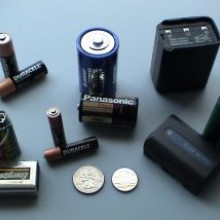
34:33 - Bipolar Batteries could be Better
Bipolar Batteries could be Better
with Dr Andrew Loyns, Atraverda
Ben - So far, we've heard that electric cars have a great deal of potential but they're held back by their weight, capacity and the expense of their batteries. So new types of batteries are actually essential to seeing more electric cars on the road. Dr. Andrew Loyns is the Chief Technology Officer for Atraverda. A company working with the University of Glamorgan in developing a new type of battery. Hi, Andrew. Thanks for joining us.
Andrew - Good evening, Ben. How are you?
 Ben - Very well. Thank you. What's the problem with existing batteries? What's wrong with them?
Ben - Very well. Thank you. What's the problem with existing batteries? What's wrong with them?
Andrew - One of the problems with batteries generally is that it's always some kind of a trade-off either between the operating performance of those batteries and their actual cost. Another issue of course is obviously safety. So the more power that you're trying to condense in a smaller space, although it will give you more energy, it has the potential if it isn't controlled properly to cause issues in terms of safety.
Ben - I think we saw this a few years ago with laptop batteries which spontaneously combusted.
Andrew - Indeed. And obviously, these lithium battery industries working extremely hard to get those issues out in the open and to understand the types of processes that they're having to go through, in order to build the batteries safely.
Ben - And you're developing what is essentially a new type of battery. What's the difference with your battery compared to the ones we've heard about already?
Andrew - Our battery is an advanced battery based on lead-acid chemistry. So, lead-acid is basically safe. It is proven. It's been around for over 100 years and it is almost 100% recyclable. So, for every spent battery, you actually create a new battery out of it. What Atraverda is trying to do is to overcome the issue that people have with lead-acid batteries and that they tend to be bulky and heavy. So, what we've done is create what's known as a bipolar battery and that basically means that we get rid of all the inert heavy lead parts within the battery and put in our proprietary conductive ceramic which act as what's known as bipole. So what happens there is you have the negative active mass and the positive active mass of the battery on the same plate. So it's a far more efficient system.
Ben - So it could be much more compact. Lead-acid batteries are what we're using in cars at the moment, aren't they? And they are heavy. They're big chunky things.
Andrew - Well, absolutely and as you were talking earlier, what you do have there however is a tremendous amount of power and that's down to the number of lead grids that you have in creating a very high surface area. So that's what creates that power that you need in order to crank an engine.
Ben - And so, what's the difference really between these mono and bipolar batteries? Can you get the same power from them?
Andrew - You certainly can because you have a much shorter current path. So, the plates within a bipolar battery just like Atraverda's building are very close whereas in a conventional product, you have quite a torturous path to get all the energy from the power from the bottom of the grids through all of the lead parts and out of the terminals. So, the potential is certainly there to give you a higher power product.
Ben - So essentially, you can get a great and more power and great and more capacity for the same volume?
Andrew - Yes and the principal reason for that is that you're taking a lot of the heavy lead parts out and therefore, you are actually filling the space with more active parts rather than inactive parts simply.
Ben - And we've already talked about electric cars today. Isn't that the sort of place you see these bipolar batteries being put in place?
Andrew - Yes, it is. It's quite interesting actually. The whole of the energy storage markets and low carbon vehicles is obviously becoming a hot topic. But it's interesting that lead-acid batteries have been used in electric vehicles for a long, long time. Now, you did talk earlier on above, go-carts for instance and in Asia, in parts of the world like China and India, what's known as e-bikes and e-scooters are absolutely booming. And because of the cost benefits of the lead-acid system, they do generally tend to be lead-acid batteries. So, those are two areas which we at Atraverda feel that we can really get into. Simply because we are basing our battery system as I said early on, a proven chemistry, but also can take out some of the heavy lead and therefore, make a smaller, less bulky product.
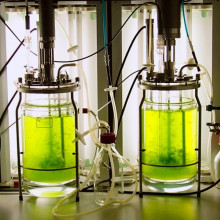
39:54 - Filling Up with Algae
Filling Up with Algae
with Anna Stephenson, Cambridge University
Helen - Now, electric cars are not the only option we have for sustainable personal transport. Already, there are a number of vehicles on the roads that use biodiesel and that's diesel that doesn't come from fossil fuel but from living creatures, from living plants. Now, Anna Stephenson is a PhD student at the University of Cambridge and she's looking at alternative ways to meet the demand for biodiesel. So Anna, hello. Thanks for coming in to the studio.
 Anna - How's it going?
Anna - How's it going?
Helen - And first of all, could you tell us what are biofuels and why do we need them?
Anna - Okay. Well, the idea of a biofuel is that you might be able to get it to be carbon neutral and this is because when you burn carbon which is a plant, it's carbon which is being stored or fixed during the life of the plant. Therefore, when you burn it, you're releasing the carbon dioxide which is being fixed during its life and therefore, it's not releasing carbon dioxide which has been stored underground which is what you do when you burn fossil fuels.
Helen - So that's really old carbon, isn't it?
Anna - Yes.
Helen - It's fixed...
Anna - Yes.
Helen - ...millions of years ago. So, we kind of don't count anymore but...
Anna - Yes, precisely.
Helen - ...doing it sort of in a neutral way by absorbing it and then releasing it in a sort of short space of time.
Anna - Yes. So it then contributes to global warming. That's the idea but in reality, biofuels do require many inputs which are in the form of fossil diesel or things which have been made, using fossil energy. For example, fertilizers and also, in fertilizers are added to soil, they release nitrous oxide which is a very potent greenhouse gas. So, in reality are not carbon neutral but the aim is to be able to make carbon neutral biofuels.
Helen - So that's what we're kind of working towards. So I believe there was what's called the first generation of biofuels, wasn't it?
Anna - Yes.
Helen - And so, that's really the sort of crops that we could actually eat, things that produce oil like grape seed and soya, is that right?
Anna - Yes.
Helen - And there were lots of problems associated with those kinds of crops weren't they?
Anna - Yes, there were many problems. For example, palm oil is the main oil which is used in Malaysia and Indonesia and because of that, a lot of rainforests are being chopped down, and killing orangutans but also, releasing loads of carbon dioxide and actually, contributing a lot more to global warming than the actual saving of getting from using the biodiesel. Also, there are issues to do with competition with food crops for land. So, power in biofuels really have a long way to go.
Helen - It is now talk about here we should be using that land for food and you know, that's not really a fair use of it. So I think, at the moment, it seems quite a lot of bad feeling about biodiesel really, isn't there in the press and so on.
Anna - Yes.
Helen - But we've got a second generation we're working towards...
Anna - Yes.
Helen - ...a new way of doing it. What does that involve?
Anna - Well, at the University of Cambridge, we're doing a lot of research into biodiesel from algae and algae have got a high photosynthetic efficiency which means that we can produce a lot of oil from the sunlight, and this oil, we can then turn into a biofuel.
Helen - And so this, it's seaweed, is it?
Anna - Yes.
Helen - The kelps and things like that or different types? What sort of species can we use for these sort of things?
Anna - There are many different types of algae but they're mainly macro algae and micro algae species and in Cambridge, we're mainly focusing on micro algae which is single cells, but in other areas, we're also looking at large macro algal species in a form of kelp, so seaweed.
Helen - Are they all salt water species or ...
Anna - No. They are both fresh water and salt water, but obviously, that's the advantage that if you're using sea water, then you don't have the issues associated with using a lot of fresh water and that benefit...
Helen - Because that's another problem, isn't there? With sort of the first generation of biofuels is that they use lots of freshwater and that's another limited product really in the world and...
Anna - Yes.
Helen - ...we might need that for other things as well.
Anna - Yes.
Helen - And another reasons why using algae is maybe a really likely way of creating good and carbon neutral biofuels in the future.
Anna - Yes. Well, the other thing is that you can produce significantly more oil per hectare, using algae, rather than landbased crops. And this is because you're not producing the leaves and the stalks and all these things which associate with land based crops.
Helen - How do we actually grow - I'm sorry. I can't try and imagine.
Anna - Yes.
Helen - Can we sort of putting them in ponds or how are we doing it?
Anna - There are two main ways of growing them. Either in ponds like large raceway ponds. That's how it's mainly grown and harvested because at the moment, algae is also used as a food source. People eat it.
Helen - Sorry?
Anna - People eat.
Helen - Yes. Do they? Really? Goodness. Okay.
Anna - Yes. But you can also use closed systems which are called, 'Photobio reactors.'
Helen - It's a big kind of just sort of very big containers really.
Anna - Big fish tanks basically...
Helen - Right.
Anna - ...which have got CO2 bubbling through them.
Helen - Right.
Anna - And that they have the benefit because you won't have competition from other algal species because if you've got a large pond then other species can get in and overtake. But the thing is, you needed quite a lot of material and there's energy associated with producing that material for a tank. So, there are benefits for each.
Helen - So you really got to look at that whole balance between what you're using and what you're getting out of it. And how do you actually create biodiesel from the algae? How do you go? You can't presume you can't just sort of squash it up and then put it in your car.
Anna - No, no. So, it's the same as conventional biodiesel which is an esterification process with methanol. So what you do is you get your algae and you grow it under specific conditions to be able to produce an algal lipid or an oil and really, what we wanted to try glyceride oil.
Helen - That's a type of fat, isn't it?
Anna - Yes, a fat.
Helen - It's basically a type of fat. Right.
Anna - And then you have to remove the fat and there's a lot of research into trying to do this in an energy efficient way because the thing is, there's a lot of water which is with the algae. And so, we want to have an extraction process which will be able to do this energy efficiently and not have to remove all of the water in, for example, in a step which requires a lot of heat.
Helen - Right, because it's all about trying to make this as efficient as possible. So we can actually achieve that goal...
Anna - Yes.
Helen - ... of being carbon neutral.
Anna - Yes. I mean, what would be ideal is if you could grow algae to have a really high lipid content of maybe 60% and if you were able to light small holes in it and then let the oil just go out into the water and have it set for its layer of water and oil and then if you were able to extract the oil in that way, then you won't need to remove all the water using fossil energy. And so, then you have your oil and you use esterification standard process to produce the biodiesel.
Helen - So these are all things we're working towards?
Anna - Yes.
Helen - And just very quickly to run that up, in all likelihood, when do you think we might see these actually being used, these algal based biodiesels?
Anna - Well really, it's in its infancy at the moment. I'd say in 10 to 15 year's time.
Helen - And so, not too far off but we still got a bit of a weight at this.
Anna - Yes.
Ben - Anna, you've just been talking about how we can use algae to make biodiesel. But one thing you said was that we need them to be as fatty as possible.
Anna - Yes.
Ben - How do you make that happen?
Anna - Well, there are many different species of algae available to us, just to naturally occurring species and there are many species which are fast growing and many species which produce lipids and there's a lot of research into finding the ideal species which is both quick at growing and also, will produce a lot of fat. So, that's the research which is going on at the moment. There is the potential that genetically modifying different species as well, but obviously, that has issues associated with it.
Ben - But it does seem that if you can find the gene that says, you know, "I make lipid." And express it as much as possible in whatever species of algae you've chosen. Then you should be able to make some in this really efficient and really could make an awful lot of biodiesel in a very small space for relatively little cost.
Anna - Yes, that's the plan.
Ben - Wonderful. Well in fact, there were buses in Cambridge that run on biodiesel, I know that much.
Anna - Yes, there are. Yes, indeed.
Ben - And I know that where I used to live in Aberystwyth when I was a student at the University of Wales Aberystwyth, there was at least one van that was clearly running on homemade biodiesel because as it went past, it smelled very strongly of fish and chips.
Anna - Fish and chips. You do hear about sort of people going to the fish and chip shop and asking for old, used oil and putting that into their cars which works on a small scale but obviously, we can't do that everywhere. Otherwise, all we'd ever eat was fish and chips, I think, wouldn't it?
Ben - And we did report on the Naked Scientists a little while ago that using oils extracted from coffee to do the same thing. So, that would actually smell really nice.
Anna - I'd just be wanting to drink coffee all the time walking past coffee shops and just feeling the need for coffee. That would be terrible.
Ben - Anna, would the algal biodiesel smell of pond perhaps? Smell of nice freshwater in sunny days?
Anna - No. I don't think so because once you've extracted the oil then it won't have any of the algal remnants left apart from the oil.
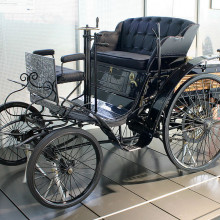
49:27 - How do I save carbon with a new car?
How do I save carbon with a new car?
We put this to Pablo Päster, Vice President of Greenhouse Gas Management at Climate Check and columnist at treehugger.com:So, unfortunately, there is no easy answer. It really depends from vehicle to vehicle, not only the vehicle that you're currently driving that you would be replacing but also, the vehicle that you would replacing it with. The U.S. government came out with a model for figuring out the energy as to make a vehicle called, 'GREET.' And basically, it tells you how many BTUs it takes to build a car. The manufacturing of the average car is roughly equivalent to 880 gallons of gasoline, in terms of the energy that's used. If a new car will save at least as much gas, it definitely makes sense to get rid of the old car. If we've seen that your old car has around 100,000 miles left on it with good maintenance, your new car would need to be at least 6 miles per gallon better to make up for the emissions for manufacturing. That means that if your old car gets less than 24 miles per gallon makes environmental sense to get a new car that gets 30 miles per gallon or better. Not only can you feel better about your environmental impact, but you also get a Ã?,£2000 discount on your new car.
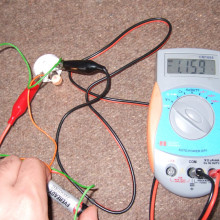










Comments
Add a comment